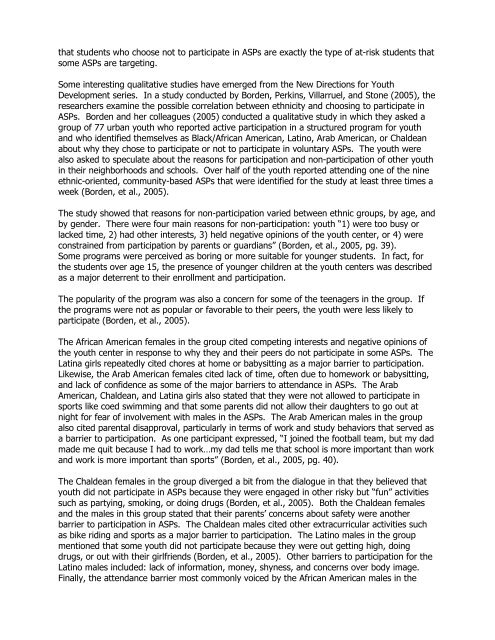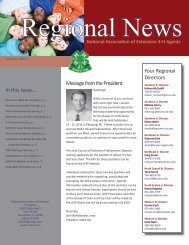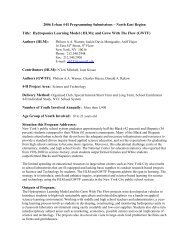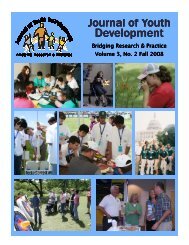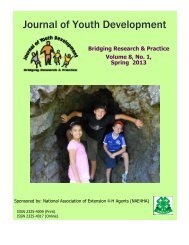However, the literature is mixed in regards to the definition <strong>of</strong> high quality programming. TheHarvard Family Research Project (2003) provided an overview <strong>of</strong> 27 evaluations <strong>of</strong> after-schoolprograms that used experimental and quasi-experimental research designs to make statementsabout program outcomes. Results from this study suggest that after-school programcomponents and factors that yield greater benefits for youth are programs that match programcontent and scheduling to participant’s needs (i.e. the need to make money or flexiblescheduling), programs that keep teens involved with opportunities for leadership, andcommunity service programs.Lauver and Little (2005) report that paid employment yields greater benefits for teens,especially those in low-income communities, while Rhodes (2004) stresses that caring youthstaffrelationships are extremely important. In terms <strong>of</strong> recruitment and retention strategies,Lauver and Little (2005) state that there are three critical elements to quality after-schoolprogramming. These include: “1) a sense <strong>of</strong> safety and community that is both physical andpsychological, 2) committed program staff who develop supportive relationships with youth, and3) challenging, age-appropriate, and fun program activities” (pg. 72).Despite the potential benefits <strong>of</strong> ASPs, attrition is a major concern and threat to theirprosperity. In a national evaluation <strong>of</strong> the 21st Century Community Learning Center program,25% <strong>of</strong> the participants withdrew in the first two months <strong>of</strong> their ASP (HFRP, 2004).Additionally, in Weisman and Gottfredson’s (2001) evaluation <strong>of</strong> eight different ASPs involved inthe Maryland After-School Community Grant Program, “withdrawal interviews” showed that33% <strong>of</strong> the students found the program boring, 19% <strong>of</strong> the students had relocated to adifferent area and could not attend the after-school program and 14% <strong>of</strong> the students hadtransportation problems that caused them to drop out <strong>of</strong> the program. Indeed, the literaturecommonly finds that it is difficult to retain teen participants because <strong>of</strong> a lack <strong>of</strong> interestingactivities.In a study <strong>of</strong> three Boys and Girls Clubs <strong>of</strong> America in New York and five in Boston, about 44%<strong>of</strong> the teens in the Boston clubs and 54% <strong>of</strong> the teens from the New York clubs citeduninteresting activities as the main barrier to participation (Herrera & Arbreton, 2003). Finally,the Harvard Family Research Project (2004) states that most ASPs experience attrition rates <strong>of</strong>20-40% and most commonly lose participants early in the program year due to boredom and/ora lack <strong>of</strong> interesting program activities.High attrition rates can be particularly problematic if there are systematic differences betweenthe youth who drop out <strong>of</strong> ASPs and those who remain in ASPs. For example, youth who dropout <strong>of</strong> ASPs may come from low-income homes or single parent households. They may havelearning disabilities that may negatively impact their ability to perform in an after-schoolprogram setting. These youth may be less likely to remain in ASPs than youth without theseproblems and may be in need <strong>of</strong> more individualized after-school care. These differences areespecially salient for program implementers seeking to positively impact at-risk populations <strong>of</strong>youth. If more at-risk youth are dropping out <strong>of</strong> ASPs then the chances <strong>of</strong> reducing delinquentbehavior is diminished. Indeed, the literature on the effects <strong>of</strong> selection bias tell us that thosewho remain in after-school programs are more likely to perform well in other areas <strong>of</strong> liferegardless <strong>of</strong> participation in the ASP (HFRP, 2004). In other words, those who choose toparticipate in ASPs are not necessarily at-risk and are systematically different from those whochoose not to participate in ASPs. Similarly, Weisman and Gottfredson’s (2001) study shows
that students who choose not to participate in ASPs are exactly the type <strong>of</strong> at-risk students thatsome ASPs are targeting.Some interesting qualitative studies have emerged from the New Directions for YouthDevelopment series. In a study conducted by Borden, Perkins, Villarruel, and Stone (2005), theresearchers examine the possible correlation between ethnicity and choosing to participate inASPs. Borden and her colleagues (2005) conducted a qualitative study in which they asked agroup <strong>of</strong> 77 urban youth who reported active participation in a structured program for youthand who identified themselves as Black/African American, Latino, Arab American, or Chaldeanabout why they chose to participate or not to participate in voluntary ASPs. The youth werealso asked to speculate about the reasons for participation and non-participation <strong>of</strong> other youthin their neighborhoods and schools. Over half <strong>of</strong> the youth reported attending one <strong>of</strong> the nineethnic-oriented, community-based ASPs that were identified for the study at least three times aweek (Borden, et al., 2005).The study showed that reasons for non-participation varied between ethnic groups, by age, andby gender. There were four main reasons for non-participation: youth “1) were too busy orlacked time, 2) had other interests, 3) held negative opinions <strong>of</strong> the youth center, or 4) wereconstrained from participation by parents or guardians” (Borden, et al., 2005, pg. 39).Some programs were perceived as boring or more suitable for younger students. In fact, forthe students over age 15, the presence <strong>of</strong> younger children at the youth centers was describedas a major deterrent to their enrollment and participation.The popularity <strong>of</strong> the program was also a concern for some <strong>of</strong> the teenagers in the group. Ifthe programs were not as popular or favorable to their peers, the youth were less likely toparticipate (Borden, et al., 2005).The African American females in the group cited competing interests and negative opinions <strong>of</strong>the youth center in response to why they and their peers do not participate in some ASPs. TheLatina girls repeatedly cited chores at home or babysitting as a major barrier to participation.Likewise, the Arab American females cited lack <strong>of</strong> time, <strong>of</strong>ten due to homework or babysitting,and lack <strong>of</strong> confidence as some <strong>of</strong> the major barriers to attendance in ASPs. The ArabAmerican, Chaldean, and Latina girls also stated that they were not allowed to participate insports like coed swimming and that some parents did not allow their daughters to go out atnight for fear <strong>of</strong> involvement with males in the ASPs. The Arab American males in the groupalso cited parental disapproval, particularly in terms <strong>of</strong> work and study behaviors that served asa barrier to participation. As one participant expressed, “I joined the football team, but my dadmade me quit because I had to work…my dad tells me that school is more important than workand work is more important than sports” (Borden, et al., 2005, pg. 40).The Chaldean females in the group diverged a bit from the dialogue in that they believed thatyouth did not participate in ASPs because they were engaged in other risky but “fun” activitiessuch as partying, smoking, or doing drugs (Borden, et al., 2005). Both the Chaldean femalesand the males in this group stated that their parents’ concerns about safety were anotherbarrier to participation in ASPs. The Chaldean males cited other extracurricular activities suchas bike riding and sports as a major barrier to participation. The Latino males in the groupmentioned that some youth did not participate because they were out getting high, doingdrugs, or out with their girlfriends (Borden, et al., 2005). Other barriers to participation for theLatino males included: lack <strong>of</strong> information, money, shyness, and concerns over body image.Finally, the attendance barrier most commonly voiced by the African American males in the
- Page 2 and 3:
Winter 2008Volume 3 Number 3Editor
- Page 5:
Examining the Potential Unintended
- Page 8 and 9:
centered, multidisciplinary approac
- Page 10 and 11:
Volume 3, Number 3, Winter 2008Arti
- Page 12 and 13:
fostering skill learning and positi
- Page 14 and 15:
Table 1Participation in out-of-scho
- Page 16 and 17:
ResultsOur analyses were conducted
- Page 18 and 19:
watching TV, playing video games or
- Page 20 and 21:
Accordingly, this research augments
- Page 22 and 23:
Dotterer, A.M., McHale, S.M., & Cro
- Page 24 and 25:
A Descriptive View of the 4-H Club
- Page 26 and 27:
In this paper, the results of a cro
- Page 28 and 29:
section is a set of statements that
- Page 30 and 31:
Table 3Experience in the 4-H clubNo
- Page 32 and 33:
significantly higher than Caucasian
- Page 34 and 35:
p
- Page 36 and 37:
This study focused only on the 4-H
- Page 38 and 39:
Theokas, C., Lerner, J.V., Phelps,
- Page 40 and 41:
Volume 3, Number 3, Winter 2008Arti
- Page 42 and 43:
potential for reaching audiences, d
- Page 44 and 45:
Putting Marketing Concepts into Pra
- Page 46 and 47:
2. Find out what others think about
- Page 48 and 49:
Diem, K.G. (1994). What do youth li
- Page 50 and 51:
Promoting Supportive Relationships
- Page 52 and 53:
focused on youth-adult relationship
- Page 54 and 55:
Conversely, more modern educational
- Page 56 and 57:
perhaps most importantly, the effic
- Page 58 and 59:
Organized youth programs, when stru
- Page 60 and 61:
likely to internalize the positive
- Page 62 and 63:
Ellis, J.M., & Caldwell, L.L. (2005
- Page 64 and 65:
Schweinle, A., Meyer, D.K., & Turne
- Page 66 and 67:
Volume 3, Number 3, Winter 2008Arti
- Page 68 and 69:
This study uses the “5 Cs” mode
- Page 70 and 71:
ResultsIn this analysis 48 codes we
- Page 72 and 73:
Table 3Inductive Codes Classified b
- Page 74 and 75:
CompetenceCompetence in organized s
- Page 76 and 77:
ecause of him (the coach)…. You d
- Page 78 and 79:
practices and competitions, the gir
- Page 80 and 81:
Eccles, J.S., & Gootmann, J.A. (Eds
- Page 82 and 83: Smoll, F.L., & Smith, R.E. (2002).
- Page 84 and 85: Volume 3, Number 3, Winter 2008Arti
- Page 86 and 87: The present work builds upon that o
- Page 88 and 89: MethodSample and Data CollectionAs
- Page 90 and 91: (scores ranging from 0 to 8) and a
- Page 92 and 93: Table 2Paired Sample T-tests Compar
- Page 94 and 95: Hypotheses 5 and 6 were tested by c
- Page 96 and 97: De Coverly Veale, D.M.W. (1987). Ex
- Page 98 and 99: Story, M., Neumark-Sztainer, D., Sh
- Page 100 and 101: Volume 3, Number 3, Winter 2008Arti
- Page 102 and 103: Cronbach’s Alpha Score For Youth
- Page 104 and 105: 12 to 18 years old. Fourteen of the
- Page 106 and 107: Therefore, there was a mixed relati
- Page 108 and 109: Youth respondents identified two ob
- Page 110 and 111: are developed through working in a
- Page 112 and 113: Seevers, B.S., & Dormody, T.J. (199
- Page 114 and 115: Volume 3, Number 3, Winter 2008Arti
- Page 116 and 117: With the many opportunities that yo
- Page 118 and 119: meaningfully reduced involving dedu
- Page 120 and 121: StaffingXTime/Schedule X X XTrainin
- Page 122 and 123: “Involving adults that will allow
- Page 124 and 125: “They can't drive or do not have
- Page 126 and 127: page in understanding why youth voi
- Page 128 and 129: Parker, L. (1999). If all youth ser
- Page 130 and 131: Volume 3, Number 3, Winter 2008Arti
- Page 134 and 135: group was the quality of the progra
- Page 136 and 137: Table 1Reasons for Non-Attendance:
- Page 138 and 139: easons given was six. Sixty-three p
- Page 140 and 141: The non-family-related activities t
- Page 142 and 143: “Catch ‘Em Being Good:”An Ext
- Page 144 and 145: In 2001, the WVUES received a schoo
- Page 146 and 147: to leverage the resources of the co
- Page 148 and 149: 4. Most primary behavior incidents
- Page 150 and 151: Recommendations for developing prog
- Page 152 and 153: Cross-Cultural UnderstandingThrough
- Page 154 and 155: that plague these nations such as p
- Page 156 and 157: 2003). Youth leadership training in
- Page 158 and 159: • enable these young people to pa
- Page 160 and 161: We believe that the USPORT program
- Page 162 and 163: West Virginia’s Response to theRo
- Page 164 and 165: Ensuring good oral health requires
- Page 166 and 167: Table 1Correlations between Planner
- Page 168 and 169: problems in this rural state…This
- Page 170 and 171: Volume 3, Number 3, Winter 2008Arti
- Page 172 and 173: vacuum. Determination of factors, a
- Page 174 and 175: ReferencesBaldwin, C., & Caldwell,
- Page 176 and 177: Volume 3, Number 3, Winter 2008Arti
- Page 178 and 179: Purpose of StudyThe purpose of this
- Page 180 and 181: Students in the High computer gamin
- Page 182 and 183:
Do Higher Levels of 4-H LeadershipA
- Page 184 and 185:
IntroductionEmotional Intelligence
- Page 186 and 187:
second section examined demographic
- Page 188 and 189:
a constructive manner. The group is
- Page 190 and 191:
differences in the scores for the 1
- Page 192 and 193:
Adaptability include “Reality Tes
- Page 194 and 195:
ReferencesAmerican Academy of Pedia
- Page 196 and 197:
Healthy Kids, Healthy Families:A Co
- Page 198 and 199:
and a half million U.S. youth (ages
- Page 200 and 201:
Families. In partnering counties, p
- Page 202 and 203:
Healthy Families was then offered a
- Page 204 and 205:
Kamberelis, G., & Dimitriadis, G. (
- Page 206 and 207:
Volume 3, Number 3, Winter 2008Arti
- Page 208 and 209:
Change It Up!What Girls Say About R
- Page 210:
In addition, the study summarizes t


